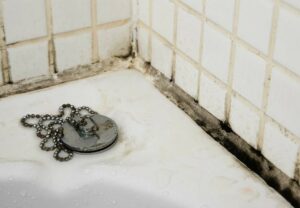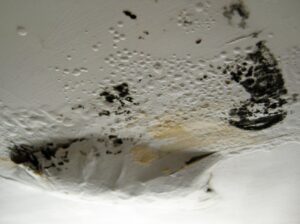Does Your Home Have Toxic Black Mold?
What’s the difference between Mold that’s black and toxic black Mold? Keep scrolling to see if you need some bleach, or call a professional!
Only Black mold
The most common black Mold is Cladosporium, which has no known toxic side effects. This type of Mold is common both inside and outside of the home. Heavy exposure to black Mold could trigger an increase in allergy and asthma symptoms. This Mold is typically found in bathrooms around grout lines and other places like basements where there can be high traffic of humidity and condensation.
Other black molds include Alternaria, Aureobasidium, Dresclera, Pithomyces, Stemphylium, and Ulocladium.
None of these are toxic molds that produce mycotoxins, but Alternaria can cause severe allergy symptoms.
This Mold is something you can tackle at home with hot water and cleaning solutions to scrub them off.
More about how to clean Mold off of surfaces.

The mold is Toxic Black Mold.
Toxic Black Mold (Stachybotrys Chartarum) releases spores as it spreads on materials that have had moisture from humidity or water damage in your home. Materials like carpet, drywall, insulation, or water-absorbent items like furniture.
This Mold releases mycotoxins which are toxic chemicals that are present in mold spores that get released into the air and can then be inhaled.
Black toxic Mold can cause danger to human health when ingested or inhaled. For this Mold to grow, the material must be wet for at least 72 hours and have consistent moisture for continued growth.
What Does Black Mold Look Like?
- Black Mold is greenish-black. It is slimy but also can be dry and powder-like if the water source is removed.
- Several types of black molds look like toxic black Mold. The only way to be sure what type of Mold you are dealing with is to have a professional test it. You could try an at-home mold testing kit, but letting professionals take care of it is always a better solution.
- Find a local mold expert in your area to answer your questions.

Symptoms of Black Mold
- Respiratory Problems
- Skin Inflammation
- Hemorrhage
- Irritation of the Mucus Membranes
- Internal Organ Damage
- Mental Impairment
- Fatigue
- Nausea
- Suppressed Immune System
Talk to your doctor if you are experiencing these symptoms, and contact your local mold removal team.
How to Remove Toxic Black Mold
- Never remove toxic black Mold on your own. Disturbing black Mold can make huge releases of spores & mycotoxins throughout your home. You are making symptoms much worse and spreading Mold elsewhere in the home.
- Talk to a professional mold removal service experienced in removing toxic black Mold.
- It’s best to have temporary lodging in a different location until the toxic Mold has been removed from your home to avoid further damage to you, your family, your pets, and your home.
How to Treat Toxic Black Mold
- No cure can be taken for toxic black Mold. You can only remove it completely or remove it yourself.
- When black Mold is removed, you will see the difference in air quality and your symptoms. However, there can be long-term or permanent effects as well.
